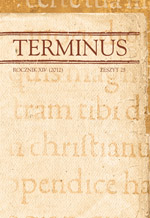Obraz i słowo w kazaniu Aleksandra Dubowicza pod tytułem Wyprawienie osoby upamiętniającym postać Janusza Skumina Tyszkiewicza
The Picture and the Word in Aleksander Dubowiczs Sermon Titled Dispatching Person Commemorating the Figure of Janusz Skumin Tyszkiewicz
Author(s): Michał KuranSubject(s): Language and Literature Studies
Published by: Wydawnictwo Uniwersytetu Jagiellońskiego
Summary/Abstract: The article shows different forms of pictorial thinking, particularly emblematic in funeral sermons, an example is Aleksander Dubowicz oration to honour Janusz Skumin Tyszkiewicz. In the funeral compositions from the Tyszkiewicz family, we see testimony of transformations, which take place in the early stages of developmental relationships between emblematic culture and occasional literary output. In the Sermon on funeral B. Naruszewiczówna and in Dispatching Person we find some elements, which determine a record of ornamental contents presented in the occasional funeral ceremony. The sermon to honour Tyszkiewicz fits this particular role; it is a prime example of emblematic construction and the function of inscription. The subscription is the praise of the deceased throughout the sermon by illustrating different roles he played in life. The entire concept of A. Dubowicz sermon is based on world vision as a theatre. He cast God in the role of director and a man as an actor which plays various roles. The orator splits peoples lives like a play, into acts preceded by a prologue and supplemented by an epilogue. In this conceptual world-theatre, A. Dubowicz superimposes a suitable biographical funeral oration schema: “Born gate” serves to display the deceaseds family (leaf B3–Dv); “Youth prologue” characterizes the virtues acquired during the time of education (l. Dv–D4v); “Soldier person” describing courageous service to the king (l. D4v–F); “Senators person” talks about Tyszkiewicz wisdom, which his commitment appears through his affairs of state in the senate and contains laudation to the deceased as learned (l. F–G2); “Epilogue” brings a description of religious death (l. G2–H2), while “Death gate” is a supplement of the allegorical word as theatre (an actor after finishing the spectacle strips of their vestments) and the deceaseds laudatory biography comes to a summary conclusion. Emblematic thinking is shown on various levels: as preachers exemplum, as a central oratorical idea; organizing whole statement structure by reference to the iconic element, which was located before the oration, like in Dispatching Person.
Journal: TERMINUS
- Issue Year: 14/2012
- Issue No: 25
- Page Range: 119-135
- Page Count: 17
- Language: Polish

